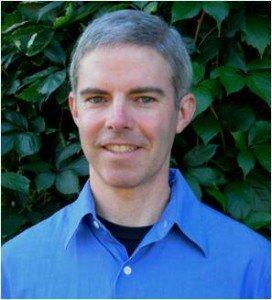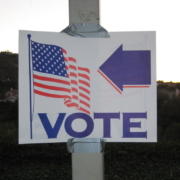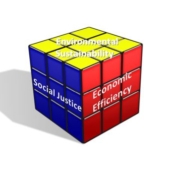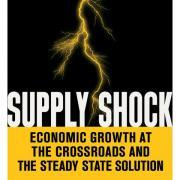Why Do We Assume More Equals Better?
by Rob Dietz
Choosing a college (not to mention getting in) can be a trying experience, especially for the nerdier souls among us. In my case, I had absolutely no plan for what to do with the rest of my life, so I selected a big university that offered degrees and classes in everything. I figured that I could explore several branches of knowledge, take a few detours down unusual alleys of academia, and figure something out for my future along the way. That’s how I ended up in Marketing 101 as a freshman. And reflecting on the offerings of that class, I’m pretty sure the whole thing was based on an erroneous assumption.
Before attending the class, I didn’t really know what marketing was. In fact my preconceived notions about marketing came mostly from cartoon characters who inhabited the Technicolor landscape of sugary breakfast cereals: Count Chocula, Tony the Tiger, Cap’n Crunch, the cuckoo bird who becomes agitated in the presence of artificial choco-balls, and the leprechaun who refuses to share his bounty of marshmallows with sugar-starved children. The class was structured around the 4 P’s (product, price, place, and promotion), a mnemonic to remind students that a marketer has to consider an awful lot of stuff to sell a product. Much to my disappointment, neither the professor nor the textbook entered the realm of children’s breakfast cereals, but we certainly did explore case studies from other sectors to get a sense of what makes a successful marketing strategy.

What feats of marketing can differentiate these two seemingly identical products? Wouldn’t this be the most instructive marketing case study of all time?
The first and most carefully considered case study was the United Colors of Benetton. It was all about “branding.” We studied how the company had used international flair and bright colors to sell lots and lots of clothes. The point for us students was to learn some things about branding that might help us blossom into successful marketers. Looking at that class in the rearview mirror today, I see that a faulty assumption formed the foundation of everything we studied. Let’s call it the BIG ASSUMPTION. Simply put, the BIG ASSUMPTION is that more is better. Without question, the Benettons of the business world should always sell more, and marketing techniques should be used to achieve that outcome.
Why is the BIG ASSUMPTION always there, and why does it go unquestioned, especially at a university with a big-name business school? It all has to do with visibility. The upsides of successful marketing campaigns — of selling more — show up right in front of our faces, popping with bold, Benetton colors. When you sell more, you get more money. And more money gets you more perks — more jobs, more toys, more status, more choices about where you live, what you eat, and what you wear. This lesson gets ingrained in our thinking and worldview from an early age. By college, I certainly understood it.
I used to go to the ATM in the student union to take out cash for food on the weekends (the dining halls were closed on Saturdays and Sundays). On one such occasion, I stuck my card in the machine, entered my PIN, and hit the button for “account balance.” The machine spit out a slip of paper that reported my life savings at $11.43. Next I punched the buttons to request a withdrawal of $5 (that way, I’d still have $5 for the next weekend). While the machine was taking its time to count all those bills, I noticed a pile of discarded account slips strewn atop the machine. I sifted through them while the ATM continued to sift through its stacks of cash for my $5. Many accounts were of the 5-digit variety — lots of rich kids at college. As I prepared to go searching for the best deal on noodles, I couldn’t help but think what sort of gourmet meals I might be able to get with a 5-digit account instead of a 5 dollar bill.
So it’s really quite simple. The assumption to which marketing students (and just about every participant in the economy) submit is this:
More sales (through more marketing) = more money = more consumption of goods and services = better lives.
But blind submission to this assumption generates plenty of downsides. If Benetton keeps selling more, and Kellogg’s keeps selling more, and GM, and Sony, and Exxon, and Apple, and Wal-Mart, and on and on, we find ourselves bumping up against the limits to growth. But the consequences are much less visible. It’s hard to notice the climate warming. It’s hard to notice species going extinct. It’s hard to notice the drawdown of aquifers. It’s hard to… (ok, ok, you get the point). The downsides of accepting the BIG ASSUMPTION are less visible than the upsides, but there’s also another problem. The upsides accrue to a select few, while the downsides accrue to society at large. As Benetton sells more and more shirts, it makes more and more profits. Its employees enjoy higher salaries and more status. At the same time, it does not suffer the consequences from increased emissions and use of natural resources — someone somewhere else, often sometime in the future, feels the pain. In essence, the economy operates by concentrating benefits and diffusing costs, especially for those businesses with the most successful marketing departments.
To debunk an assumption, especially one with the visibility problems of the BIG ASSUMPTION, you have to study. You have to learn about the concealed downsides. For the BIG ASSUMPTION, that means studying ecology and understanding (to the extent we can) the science behind environmental systems. The author and activist Bill McKibben is certainly someone who has done his homework. His studies have led him to question the BIG ASSUMPTION. On the first page of his book, Deep Economy, he writes:
For most of human history, the two birds More and Better roosted on the same branch. You could toss one stone and hope to hit them both. That’s why the centuries since Adam Smith have been devoted to the dogged pursuit of maximum economic production… But the distinguishing feature of our moment is this: Better has flown a few trees over to make her nest. That changes everything. Now, if you’ve got the stone of your own life, or your own society, gripped in your hand, you have to choose between them. It’s More or Better.

I vant to sell you crud!
More Count Chocula actually makes everyone worse off, except of course for the few people who manufacture and market Count Chocula. By the day, it becomes more and more obvious that it’s time to replace the outdated fixation on More with a modern appreciation of Enough. The challenge is to configure the economy in such a way that people and organizations can pursue Better instead of More. Maybe we can start by overhauling Marketing 101.
 Rob Dietz brings a fresh perspective to the discussion of economics and environmental sustainability. His diverse background in economics, environmental science and engineering, and conservation biology (plus his work in the public, private, and nonprofit sectors) has given him an unusual ability to connect the dots when it comes to the topic of sustainability. Rob is the author, with Dan O’Neill, of Enough Is Enough: Building a Sustainable Economy in a World of Finite Resources.
Rob Dietz brings a fresh perspective to the discussion of economics and environmental sustainability. His diverse background in economics, environmental science and engineering, and conservation biology (plus his work in the public, private, and nonprofit sectors) has given him an unusual ability to connect the dots when it comes to the topic of sustainability. Rob is the author, with Dan O’Neill, of Enough Is Enough: Building a Sustainable Economy in a World of Finite Resources.







It’s great that someone that took Marketing has awakened so thoroughly to the Big Assumption and associated premises, no less. I liked Cocoa Krispies, Pebbles and the like as a kid myself. As recall, one used a flakier form that became mushier faster.
As far as the wealthy developing an awareness. An in-law of mine worked at NOLS, an outdoor recreation organization, and grew up with not insignificant financial privileges. I was happy to learn that she is a fan of organic foods.
I recall that at least one of the Rockefeller descendants became a conservation biologist, as did one of Ted Turner’s sons, and Paul Newman’s daughter who heads an organic food branch of Newman’s Own Co.
It seems to me an important way to alert people who are not so directly oriented is through clear accounts of pollution and degradation versus environmentally sustainable production. Even organic agriculture needs to be integrated with a more comprehensive vision of agroecology. In southern Brazil, at least one area requires a sizeable portion of untouched land by local small farmers.
In my graduate studies, especially thanks to Clive Ponting’s book Green History of the World, I extended my awareness of the significance of Love Canal, NY and the toxic waste crisis there that exploded in 1978, to the racial significance of a North Carolina incident in the 1980s that lead to the founding of the EPA’s office of Environmental Justice. Then there are European incidents like the 1970s Seveso and 1980s Basel, besides Chernobyl. This doesn’t even include reference to Cleveland’s Erie River fires of the 1960s. The Latin American region has a reference in a 1980s disaster at Cubatao, Sao Paulo, Brazil. All this in addition to the Superfund tracking website developed by Environmental Defense Fund, now maintained by another NGO, called “scorecard” or something as memory serves.
Ultimately, these accounts give environmentalists like McKibben, Dietz, and the rest of us ways to paint pictures and tell stories that can help anchor other people who haven’t quite made it to safe harbor. As for Cap’n Crunch (Crunchberry!) and the like, I’ve seen organic cereal venturing into chocolate flavoring last I recall. The health food companies represent that other aspect, the social one, that is actually inseparable from the ecological one. By supporting more companies, we get closer to one of the principles behind sustainability, broader experience of participation, not of consumer fantasy. At times I put my own organic chocolate powder on granola with milk to relive the carefree days of childhood. Cocoa Pebbles from the Flintstones in a homemade cereal concoction (hcc). That’s how we can create a wake up call benefiting from the appeal of popular cartoon images to hcc. That’s the solidarity ecological economy underlying the steady state concept, it seems to me.
I am not successful in the usual way, and thus have become accustomed to not getting everything I want… Yet I still contribute to pollution almost as much, perhaps even more than the affluent… simply because I have older, WAY less efficient stuff AND live in a house that is terrible at insulation. It doesn’t even have good south facing windows to let heat in during winter, but, even if it did, the house next door blocks it!
Anyways, no “real” job means using a desktop (instead of a much more efficient laptop), driving with an older (yet very heavy duty and reliable) Ford F350. In short, I want to say that if I had the financial ability, I would actually be contributing less, in the long run by being far more efficient… but then again, I might be tempted!
Imagine more people living a better life while using LESS energy. Without efficiency, there is no hope to live in a steady state economy. Proofs of point are the electric car and the led (which are about 4 x and 12 times more efficient than what they will replace, respectively).
However, clean energy needs lots of powerlines and space… but still, that’s BETTER than accelerating CO2 content in our air and the massive amount of local enviro damage by extracting and using fossil fuels.
Of course, there is the option (I mean the faint hope) of closed cycle molten salt thorium reactors… This would cut down on desert solar, powerlines and XSCO2.
Whatever the best choice though, it has to delete fossil fuels before we let them delete us in subsequent depletion years (and it would be nice to use that store for non burning purposes during the interim period of learning how not to need them all together)!
And I am afraid that we somehow have to delete money, as marketing 101 clearly points to an over excess of everything which is designed to fail in a set amount of time. This, I assume many already know.
Food is raised and grown for money, not for consideration of efficiency (well maybe due to the costs of inefficiency). Same with the very structure of our cities and towns.
Until humanity can collectively focus on (figuring out how to get to) the most efficient social structure, only then does “lifestyle” have a meaningful overall relevance towards sustainability.
Imagine a society which does not have personal money (I know this is still “impossible” and have not considered it on an academic level)!
By that I mean, everybody has equal ownership of “the state” and thus ALL monies are collectively, the state’s. With that, purchasing power goes to the betterment of the state, which inturn provide individuals with all that they need, albeit on an ordered and structured way.
The people willing to test this new social structure would essentially (be hoping to) be rich slaves for themselves!
Imagine all the things money can’t buy… Large renewable energy installations, free higher education, and eventually, expansion out into the solar system itself… It also would permit the mass manufacture of “everything” needed (such as cell phones, smart TV’s and cars) to be as efficient and long lasting as possible. Machines would eventually make “everything”, yet this would be the way (the only way I can see) to sidestep unemployment cause by such machines already being developed!
A closer to home (yet still far out) scenario would be that the “state” exports a single machine made commodity, such as 30% efficient GaAs fresnel arrays for literally pennies on the dollar. Since only the state could profit, and since only the people would control the state (keep them internet lines in good shape!), retail would become a thing of the past. By virtue of the co-op concept, it seems this concept would eventually prevail over personal money (at least for the majority in our economic systems).
From there, more machines are made that displace more jobs, allowing time to work on the development of yet more machines… because eventually, there will be no monies coming into the state when all other countries convert over too.
All we need from Earth are the seeds, underground mining, water and air (and sunlight). No more “marketing” the wholesale slaughter of the environment, just a little detriment due to the erection of solar arrays (which do not need bulldozed land), and or molten salt reactors (the citizens would still “need” sunlight!). Food would be hydroponically grown, same with meat? using (high power and wavelength specific) leds as artificial sunlight within large buildings. Eventually, less energy would be required as the “cheapest, easiest way” to promote “turn around” would no longer make any sense! The building of giant “3d cities” (out of graphine?) would allow “local economy” efficiencies too (not to mention smog free electric car transportation that negotiates on VERTICAL pathways and many hundreds of levels as well as wonderful views).
I would call this future social structure a “machine economy based on available resources”.